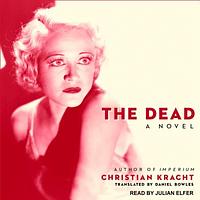Take a photo of a barcode or cover
challenging
funny
reflective
sad
adventurous
dark
slow-paced
Plot or Character Driven:
A mix
Strong character development:
Complicated
Loveable characters:
No
Diverse cast of characters:
No
Flaws of characters a main focus:
Yes
dark
sad
tense
slow-paced
Plot or Character Driven:
Plot
Strong character development:
Complicated
Loveable characters:
No
Diverse cast of characters:
Yes
Flaws of characters a main focus:
Yes
The plot is bumpy and at times perplexing. He writes very well, though and the theme is interesting. Perhaps the best way to describe would be "taut". For a German novel - it ain't a small feat...
Utterly poetic, artfully written, but weighed down by weak, uninspiring protagonists.
challenging
mysterious
slow-paced
Loveable characters:
No
mysterious
reflective
slow-paced
Plot or Character Driven:
Character
Strong character development:
No
Loveable characters:
No
Diverse cast of characters:
Yes
Flaws of characters a main focus:
Yes
adventurous
dark
mysterious
reflective
sad
tense
fast-paced
Plot or Character Driven:
Character
Strong character development:
Complicated
Loveable characters:
No
Diverse cast of characters:
Yes
Flaws of characters a main focus:
Yes
Kracht's novel The Dead is concerned with the metaphysical realities of modernity and historicity - "metaphysics of the present" as one of the protagonists admits. He creates a space where fictional people meet real historical figures, weaving the past, present, and the future. It is a novel evincing ruptures of time. Where ancient civilization intersects novelty. This is most holistically symbolized in the medium of film. Camera is THE "disembodied organ." The mechanical eye that transforms reality itself. Kracht was definitely influenced by Schrader's book on transcendental cinema.
The two main protagonists are (fictional) Swiss filmmaker Emil Nageli and the (real) officer in the Japanese Imperial Army, Masahiko Amakasu. The plot is about a fascist "cinematic axis" between Tokyo and Berlin. But the story is much more impressionistic than the clear plot line of the blurb. This is a novel of ideas through and through. It's engrossed in the shaping of nations and ideologies and cinema. The novel begins with a startling image of a man committing seppuku while a camera records. The language starts out with a violent sensuality, reflexivity. Around halfway through, there's a turn in the tone. It becomes almost slapstick. We get the babylonian decadence of Weimar, the stupidity of politicians and actors (the real Charlie Chaplin got caught up in the May 15th massacre in Japan!). Postmodern literature, done well.
The Bataillian, Mishimaian inextricability of sex, obscenity, violence, and suicide in the overarching events of history and the medium of film is present throughout. Certain things only come into being on film. While death always arouses. This is the logic and the spirit of modernity. The novel is dark. The only light and whiteness is that of cruel winter snow. Ever presence of blood-red in eerie, murderous places - jelly-like, pudding-like, congealed blood paints this novel. There are also spurts of a pale-violet, always existing out of time, either during the revealing of a disturbing truth or the occurrence of something out of nowhere.
"After wandering down a long street wreathed in flowers, at the abrupt end of which she pulls open a heavy, chiseled wooden door with some difficulty, she somewhat timidly enters the realm of the dead for a very short while, that world-in-between where dream, film, and memory haunt one another, and there she hears a disembodied aspiration; it sounds to her like a sustained hah."
This "hah" comes full circle during the death of Nageli's father, whose mysterious last words were thus, and in a moment when "rifts in time were opening up" where Masahiko encounters a cave-dwelling woman painted red. This "hah" is the transcendental element in reality, inexplicable, mocking even, unless replicated on film.
I liked this book a lot. Still have so many thoughts about it. I didn't like the tone change of the second half of the novel as much and the slightly silly plot line, but it's still enjoyable. It deserves a 3.5 overall.
Let's end with a quote:
"There are only two great principles in the world closely related to one another; sexuality and suicide. Both topoi...are permeated by transcendence and mutual interference...the great rustling beyond God can be experienced only by the one who's resolved himself into suicide, with concentrated, irrefutable, strong virility."
The two main protagonists are (fictional) Swiss filmmaker Emil Nageli and the (real) officer in the Japanese Imperial Army, Masahiko Amakasu. The plot is about a fascist "cinematic axis" between Tokyo and Berlin. But the story is much more impressionistic than the clear plot line of the blurb. This is a novel of ideas through and through. It's engrossed in the shaping of nations and ideologies and cinema. The novel begins with a startling image of a man committing seppuku while a camera records. The language starts out with a violent sensuality, reflexivity. Around halfway through, there's a turn in the tone. It becomes almost slapstick. We get the babylonian decadence of Weimar, the stupidity of politicians and actors (the real Charlie Chaplin got caught up in the May 15th massacre in Japan!). Postmodern literature, done well.
The Bataillian, Mishimaian inextricability of sex, obscenity, violence, and suicide in the overarching events of history and the medium of film is present throughout. Certain things only come into being on film. While death always arouses. This is the logic and the spirit of modernity. The novel is dark. The only light and whiteness is that of cruel winter snow. Ever presence of blood-red in eerie, murderous places - jelly-like, pudding-like, congealed blood paints this novel. There are also spurts of a pale-violet, always existing out of time, either during the revealing of a disturbing truth or the occurrence of something out of nowhere.
"After wandering down a long street wreathed in flowers, at the abrupt end of which she pulls open a heavy, chiseled wooden door with some difficulty, she somewhat timidly enters the realm of the dead for a very short while, that world-in-between where dream, film, and memory haunt one another, and there she hears a disembodied aspiration; it sounds to her like a sustained hah."
This "hah" comes full circle during the death of Nageli's father, whose mysterious last words were thus, and in a moment when "rifts in time were opening up" where Masahiko encounters a cave-dwelling woman painted red. This "hah" is the transcendental element in reality, inexplicable, mocking even, unless replicated on film.
I liked this book a lot. Still have so many thoughts about it. I didn't like the tone change of the second half of the novel as much and the slightly silly plot line, but it's still enjoyable. It deserves a 3.5 overall.
Let's end with a quote:
"There are only two great principles in the world closely related to one another; sexuality and suicide. Both topoi...are permeated by transcendence and mutual interference...the great rustling beyond God can be experienced only by the one who's resolved himself into suicide, with concentrated, irrefutable, strong virility."
dark
reflective
fast-paced
This is a whirlwind 240 pages. Jam packed with information and story, but told in a bewildering style - the language is extremely concise - and at a blinding pace.
It starts with a quite detailed description of Seppuku, and is unrelenting after that.
It starts with a quite detailed description of Seppuku, and is unrelenting after that.





